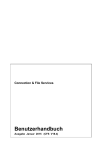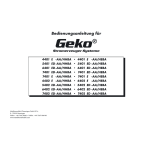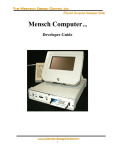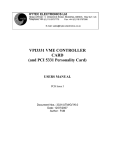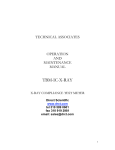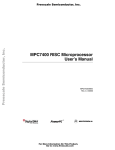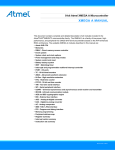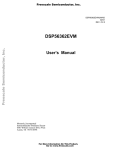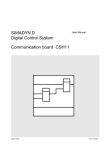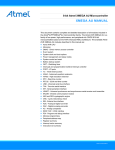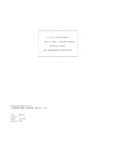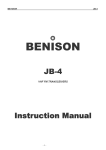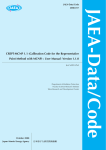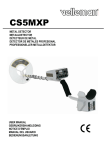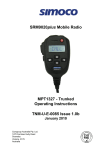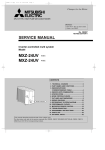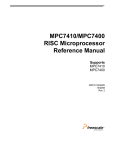Download hytec electronics ltd vtd1612 transient recorder user manual issue 3
Transcript
HYTEC ELECTRONICS LTD VTD1612 TRANSIENT RECORDER USER MANUAL ISSUE 3 Hytec Electronics Ltd 5 Cradock Road Reading RG2 0JT U.K. Tel: +44 (0)118 9757770 Fax: +44 (0)118 9757566 Email: [email protected] CONTENTS Section Page 1. Product Description 3 2. Specification 4 3. Installation 6 4. Operation 8 5. Circuit Description 20 Apendix A – Jumper Settings Appendix B – Link Settings Appendix D – Use of Analogue Triggers VTD 1612A Transient Digitiser User Manual 1. PRODUCT DESCRIPTION 1.1 DESCRIPTION The 1612A Transient Digitiser is a dual height single width VME slave board which provides the digitisation and storage of analog waveforms present on up to sixteen differential input channels, it is an upgraded version of the 1612 with a 10MHz convertor in place of the original 2MHz part.. Each input is provided with a track/hold circuit so that all channels can be simultaneously sampled. The sampled voltages are multiplexed into a fast 12 bit ADC which has its own sample/hold amplifier. The ADC digitises the voltage and stores the resultant binary information in a 128K word RAM. A 512K version is available. Memory can be allocated according to the number of inputs selected, i.e. 1, 2, 4, 8 or 16 inputs use 128K, 64K, 32K, 16K or 8K words per input. The RAM is dual–ported and provides access for both the ADC and VME bus. The board has programmable operating modes. Its main modes are:– 1.2 TRIGGERED BUFFER MODE Three clock frequencies can be selected for pre–trigger, near post trigger and far post–trigger digitisation rates. Memory is equally divided between the pre–trigger and post–trigger buffers. When the module is armed by software command, clocking occurs at the pre–trigger frequency in the pre–trigger buffer. A trigger causes digitisation to occur at the near post–trigger frequency for a specified number of samples from the start of the post–trigger buffer followed by the far post–trigger frequency for a second specified number of samples. On completion, acquisition is halted. 1.3 CONTINUOUS MODE Normally, when the ’full flag’ interrupts digitisation is inhibited. However, it is possible to set up a continuous mode wherein digitisation occurs continuously. The ’half full’ and ’full’ flags can then be used as an indication of where in the memory digitisation has reached, so that alternate halves of memory can be read whilst still acquiring data. Samples are clocked at the pre–trigger clock frequency and the whole memory is used as a pre–trigger buffer. 1.4 SINGLE SCAN MODE In this mode the pre–trigger clock is inhibited. When the VTD is triggered the input voltages are sampled and converted, the memory address pointer is incremented and the ’end of event’ interrupt status bit is set. It is possible to trigger multiple scans using post–trigger counts of greater than one. The board can interrupt for one or all of three states:– (a) (b) (c) the memory is full (completion of post–trigger) or, the memory is half full or, the end of a triggered event record has been reached. It is possible to read the contents of an addressed memory location via the VME bus whilst the board is digitising. This concurrent access mode is permitted once per ADC conversion, i.e. not exceeding a read rate of one megaword per second. At the trigger point the current memory address will be recorded in a time–stamp buffer. Up to 8192 time stamps can be recorded. The board can be triggered from an external analog source, from channel 1, by an external logic pulse, or by software command. The clock frequency can be programmed from 1MHz down to 0.01Hz using either an internal or external clock source with a maximum frequency of 8MHz. The clock is buffered and is transmitted via a front panel connector. Provision is made for connecting Clock Out to Clock In of another module. Trigger is also buffered and transmitted as a logic pulse via a connector so that one module can trigger another. 3 VTD 1612A Transient Digitiser User Manual 2. SPECIFICATIONS Operating temperature range: 0 to 45oC ambient. Power requirements: +5V at 2.5A from the VMEbus +5V STDBY maintains the RAM in the event of .power failure. (+/– 5V is generated on board). FRONT PANEL CONNECTORS ANALOG INPUTS: Connector type: 37 way D type socket. Pin allocation: 1–16 analog positive inputs, 20–35 analog negative inputs, 17 analog trigger positive input, 36 analog trigger negative input, 18, 19, 37 Gnd. Signal: +/– 10V. Gains 1–10 may be ordered on a channel by channel basis. Input impedance: 40K ohms differential. 20K ohms common mode. Input Protection: +/– 300V overvoltage for 1 second. Common mode: +/– 100V for linear operation. CMRR: 70db at 100KHz. Amplifier bandwidth: 5MHz (small signal). Trigger signal: As for analog inputs. Acquisition time: 1uS to +0.025% for a +/– 10V transition, in multichannel mode, single channel 625nS to +0.025%. Aperture jitter: 1nS max. Aperture delay: 70nS. ADC resolution: 12 bits. ADC conversion: 625nS max to hold, digitise and store. (Internal converter 100nS). Linearity error: +/– 1/2 LSB. Channel error: +/– 1/2 LSB. ADC error: +/– 1/2 LSB. Drift: +/–30 ppm per oC (max). 4 VTD 1612A Transient Digitiser User Manual DIGITAL SIGNALS: Trigger input: Lemo 00250 socket. Negative going TTL pulse. 200nS min. width. Trigger output: Lemo 00250 socket. Negative going TTL signal. Clock in: Lemo 00250 socket. Negative going TTL signal. 10MHz frequency max. Clock out: Lemo 00250 socket. Negative going TTL signal generated by internal clock or Clock In. Busy out: Lemo 00250 socket. Negative going TTL signal generated when a trigger has occurred until the end of event. FRONT PANEL INDICATORS: Armed: LED which illuminates when the input waveforms are being digitised commencing at the pre–trigger rate. Continuous: LED which illuminates when ’Continuous’ mode is set. Trigger: LED which illuminates for 200mS when a trigger occurs. Full: LED which illuminates when the memory is full. Half–full: LED which illuminates when the memory is half full. Module address: LED which illuminates for 200mS when the module is accessed from the VMEbus. Busy: LED which indicates the status of the Busy status signal. (An event is being recorded). Error: LED which illuminates when the module is addressed and bus timeout occurs. BACKPLANE CONNECTORS: The board uses the J1/P1 connector of the VMEbus. It is equipped with a jumper selectable base address and interrupt priority level. It recognises standard (24 bit) addressing. The memory map of the module is shown below: Reserved (two words) Reset memory address Board descriptor Upper/lower trigger threshold Far post–trigger frequency Near post–trigger frequency Far post–trigger clock count Near post–trigger clock count No. of channels/memory allocation ADC memory address pointer MS ADC memory address pointer LS Interrupt status Interrupt vector Time stamp data memory Conversion data memory ) ) ) ) ) ) ) ) 16 words ) ) ) ) ) ) 8K words ) 128K words Base address (jumper selectable) 5 VTD 1612A Transient Digitiser User Manual 3. INSTALLATION 3.1 JUMPER SETTINGS 3.1.1 GENERAL Install the printed circuit board jumpers in accordance with Appendix A and the component layout diagram, Appendix C. 3.1.2 BASE ADDRESS The word address can be selected from 080000 to F80000 (hex) defined by the five jumpers J12 – J16. Insertion of a jumper selects a logical 0 at that position. Thus if J12 – J15 are made and J16 is left open, base address 800000 is selected. 3.1.3 INTERRUPT ACKNOWLEDGE PRIORITY Interrupt priority from 0 to 7 can be selected with J17 – J19. Insertion of a jumper selected a logical 0. If J18 – J19 are made and J17 is left open priority level 1 is selected. This priority corresponds to selection of IRQ1 in the following paragraph. 3.1.4 INTERRUPT REQUEST The interrupt request line to be driven by the interrupt is selected by inserting one of jumpers J20 – J26. Insertion of J20 selects IRQ1*. 3.1.5 ANALOG INPUT VOLTAGE RANGE The input voltage range is selected using jumpers J1 – J4. Jumper J5 selects straight binary conversion or two’s complement (sign extended to sixteen bits). 3.1.6 INTERNAL CLOCK Jumpers J6 and J7 select the internal clock frequency to be used. In current versions J7 (8MHz) is selected. 3.1.7 SEQUENCER CLOCK PHASE The jumpers J8 and J9 select the phase relationship between the clock signals of the logic sequencers and their set–up buffer registers. The jumper is factory set and should be maintained at the current setting. 3.1.8 TRIGGER TIMING MONOSTABLE In situations where only one channel is used at the highest clock rate to ensure greatest trigger accuracy the timing monostable can be enabled by making J10. 3.1.9 POST–TRIGGER MONOSTABLE Jumper J11 is provided for test purposes. it is normally left open. When made, the jumper disables the TRIGSEQB monostable. This monostable resets the memory address counter when the board is triggered so that the post–trigger buffer commences at its zero address. Therefore when the jumper is made conversions are stored in the post–trigger buffer commencing at the current address plus the post–trigger offset. 3.2 LINK SETTINGS 3.2.1 GENERAL The printed circuit board link settings are shown in Appendix B. They are generally factory set and need not be changed for normal operation. 3.2.2. DATA LOGIC Link LK1 determines the sense of the ADC data. when pins 2 and 3 are linked, the ADC provided positive logic. Data is complemented when pins 1 and 2 are linked. 6 VTD 1612A Transient Digitiser User Manual 3.2.3 OFFSET ADJUSTMENT POTENTIOMETER VOLTAGE Link LK2 allows either a positive or negative bias voltage to be connected to the front end amplifiers according to which type of amplifier is used. Normally, OP64 amplifiers are used which require a negative voltage and pins 2 and 3 are connected. 3.2.4 CHANNEL 1 AND 4 ISOLATION Link LK3 isolates sample and hold channels 1 and 4 for test purposes. Opening the link across pins 1 and 2 isolates sample/hold channel 1. Opening the link across pins 3 and 4 isolates sample/hold channel 4. 3.2.5 MISSED TRIGGER Hardware logic is included for detection of missed triggers. However, in current versions this has not been implemented in firmware and link LK4 is not used. 3.2.6 ADC AMPLIFIER Link LK5 connects the output of the multiplexer to the input of the ADC non–inverting amplifier. It is normally made. 3.2.7 HOLD TIMING Link LK6 is normally made by connecting pins 1 and 2. 7 VTD 1612A Transient Digitiser User Manual 4. OPERATION 4.1 MEMORY MAP The conversion data memory occupies a space of 128K words starting at the base address. A memory of 8K words resides above this followed by a further 16 words used for control and status registers. The memory map is shown below: 16 words Register Space Base address +44000 Time Stamp Memory 8K words Base address +40000 Conversion Data Memory 128K words Base address (800000 – F80000) 4.2 CONVERSION DATA MEMORY For a single channel (channel 1) the memory is totally allocated. Full Post–trigger Buffer Pre–trigger Buffer { { Last Base + 3FFFE 64K Half full Base + 20000 64K 0 – 1st conversion 8 Base + 00000 VTD 1612A Transient Digitiser User Manual For two channels (channels 1 and 2) the memory is divided into two segments thus: { { { { Post–trigger Buffer Pre–trigger Buffer Post–trigger Buffer Pre–trigger Buffer Full 32K Half full 32K 1st 32K 32K Base + 3FFFE } } channel 2 Base + 30000 Base + 20000 channel 1 1st Base + 10000 Base + 00000 For four channels (channel 1 – 4) the memory is allocated as below: Full Post 16K Half full Pre 16K 1st Post Pre 16K 16K 1st Post Pre 16K 16K 1st Post 16K Pre 16K 1st 9 } } } } Base + 3FFFE channel 4 Base + 30000 channel 3 Base + 20000 channel 2 Base + 10000 channel 1 Base + 00000 VTD 1612A Transient Digitiser User Manual For eight channels (channels 1 – 8) there are 8 segments: Full Post 8K Pre 8K Post 8K Pre 8K Post 8K Pre 8K Post 8K Pre 1st 1st 1st 8K Post 8K Pre 8K Post 8K Pre 8K Post 8K Pre 8K Post 8K Pre Half full 1st 1st 1st 1st 1st 8K 10 } } } } } } } } Base + 3FFFE channel 8 Base + 38000 channel 7 Base + 30000 channel 6 Base + 28000 channel 5 Base + 20000 Base + 18000 channel 4 Base + 18000 channel 3 Base + 10000 channel 2 Base + 8000 channel 1 Base + 00000 VTD 1612A Transient Digitiser User Manual For sixteen channels (channels 1 – 16): Full Post 4K Pre 4K Post 4K Pre 4K Post 4K Pre 4K Post 4K Pre 4K Post 4K Pre 4K Post 4K Pre 4K Post 4K Pre 4K Post 4K Pre 4K Post 4K Pre 4K Post 4K Pre 4K Post 4K Pre 4K Post 4K Pre 4K Post 4K Pre 4K Post 4K Pre 4K Post 4K Pre 4K Post 4K Pre Half full 4K 11 } } } } } } } } } } } } } } } } Base + 3FFFE channel 16 Base + 3C000 channel 15 Base + 38000 channel 14 Base + 34000 channel 13 Base + 30000 channel 12 Base + 2C000 channel 11 Base + 28000 channel 10 Base + 24000 channel 9 Base + 20000 channel 8 Base + 1C000 channel 7 Base + 18000 channel 6 Base + 14000 channel 5 Base + 10000 channel 4 Base + 0C00 channel 3 Base + 08000 channel 2 Base + 04000 channel 1 Base + 00000 VTD 1612A Transient Digitiser User Manual 4.3 TIME STAMP MEMORY When the board is triggered the address of the next location in memory to be updated is stored in the time stamp memory pointed to by the Event Counter. thus after initialisation and start up the first recorded time stamp will be stored in location zero of the time stamp memory. The next will be stored in location 1 and so on up to a maximum of 8K values. If this is exceeded wrap–around will occur and the next time stamp will be stored in location zero. Location zero resides at the Base Address (BA) plus 40000 bytes. The time stamp memory occupies from BA + 40000 to BA + 43FFE. 4.4 REGISTER SPACE The control and status registers of the board occupy 16 words at the top of the memory area. These are allocated as follows: BYTE ADDRESS REGISTER BA +4401E BA +4401C BA +4401A BA +44018 BA +44016 BA +44014 BA +44012 BA +44010 BA +4400E BA +4400C BA +4400A BA +44008 BA +44006 BA +44004 BA +44002 BA +44000 READ/WRITE Reserved Reserved Reset memory address pointer to zero Module descriptor Upper/lower trigger threshold Far post–trigger frequency Near post–trigger frequency Pre–trigger frequency Far post–trigger clock count Near post–trigger clock count No. of channels/segment size ADC memory address pointer MS ADC memory address pointer LS Mask and control Interrupt status Interrupt vector – – W R W W W W W W W R R R/W R/W *W * Read during the IACK cycle. 4.5 DATA FORMATS 4.5.1 INTERRUPT VECTOR Data Bit Write D16 15 14 13 12 11 F 10 09 F 12 08 07 06 05 04 03 Vector 02 01 00 VTD 1612A Transient Digitiser User Manual Bits 00 – 07 – 8 bit vector. Bits 08 – 15 – all 1s if 8 bit vector required. 4.5.2 INTERRUPT STATUS 15 14 13 12 11 10 09 08 07 06 05 04 03 B 02 01 00 EE HF F Write D16 Bits 0–2 Read D16 bits 0–2, 15 B – Busy. Trigger has occurred and the board is in the post–trigger phase. EE – End of event. Trigger has occurred and the board is in the post–trigger phase has been completed, i.e. both near post–trigger and fast post–trigger counts have finished. HF – Half full. conversion data has been stored in the lower half of memory and the halfway boundary has been crossed. F – Full. The memory has been completely filled. Unless continuous mode is set, conversions will be disabled. Status bits 0–2 can be reset by writing 0s to each bit. The Busy bit can only be read. A logic 1 indicates that the condition read is true. Eg. if B=1 the triggered event is busy. 4.5.3 MASK AND CONTROL Data Bit 15 14 13 Write/Read D16 ST XMI XMO 12 IP 11 10 09 08 07 XC AT2 AT1 AT0 ARM 06 05 04 03 02 01 00 C XT TI EE EH EF EF – Enable ’Full’ interrupt. The top conversion data memory location has been overwritten by the ADC. EH – Enable ’Half Full’ interrupt. The halfway point of the highest memory sector has been reached. EE – Enable ’End of event’ interrupt. The near post–trigger and far post–trigger phase have been completed and the ADC is in the pre–trigger phase. TI – Trigger Internal. Trigger from channel 1 amplifier. XT – Enable external digital trigger via the front panel co–axial socket and enables software triggers. C – Continuous mode. Digitisation continues regardless of the status of the ’Full’ flag. If ’Full’ is set memory storage ’wrap–around’ will occur. ARM – Digitisation is enabled when set. AT0 – 2; Three bit analog trigger code determines mode of trigger – see Appendix D for details of usage. These codes are not implemented in early versions of the TRIGGER PLD. XC – External clock. The basic clock rate is derived from the signal applied to the ’Clock In’ socket and the internal clock is inhibited. The settings of the trigger frequencies (4.5.6) define the frequency division. IP – Inhibit pre–trigger clocking. Digitisation will not occur until the board is triggered. 13 VTD 1612A Transient Digitiser User Manual XMO – 2 bit code reserved for memory paging on future versions of the VTD 1612. ST – Software trigger. A write Mask and Control transfer with bit 15 will trigger an event. Busy will be set until the end of the end of the event. 4.5.4 ADC Memory Address Pointer LS Address Data 15 14 13 12 11 10 09 08 07 06 05 04 03 02 01 00 Read Memory Address D16 15 14 13 12 11 10 09 08 07 06 05 04 03 02 01 00 MS Address Data 15 14 13 12 11 10 09 08 07 06 05 04 03 02 01 00 Read Memory Address D16 X X X X X X X X 23 22 21 20 19 18 17 16 The memory address counter is a 24 bit address counter. The 128K word memory is addressed by bits 00 to 16. If continuous is set bits 17 to 23 give an indication of how many times memory ’wrap–around’ has occurred. The address bits 00 – 16 are used according to the memory segment allocation:– No. of channels Sector size 16 8 4 2 1 8K 16K 32K 64K 128K Memory address bits Segment address bits 00–12 00–13 00–14 00–15 00–16 13–16 14–16 15–16 16 – Note: bits 08–15 of the MS data will be set to all 1s. The memory address read buffer has a latching arrangement such that data cannot change during a read. This has two side effects. After initialisation the memory address must be read twice to obtain the current zero value of the address counter. After end of event when the address passes from post–trigger to the pre–trigger buffer the address must be read twice for the first read. This proves useful in that it can be checked that the end of post–trigger address is reached and then the corresponding address in the pre–trigger buffer is pointed to for the second read. The memory address read buffer is updated at the end of a channel scan. Therefore, the appropriate segment address bits are zero and the address points to the next location to be updated. 4.5.5 NUMBER OF CHANNELS/SEGMENT SIZE 15 14 13 Write D16 12 11 Not used C0 Code 1 : Sample channel 1 C1 Code 2 : Sample channel 1 and 2 C2 Code 4 : Sample channel 1 – 4 C3 Code 8 : Sample channel 1 – 8 Code F : Sample all 16 channels 10 09 08 07 S3 C0 14 06 S2 05 S1 04 S0 03 02 C3 01 C2 00 C1 VTD 1612A Transient Digitiser User Manual S0 Code 1 : 4K pre–trigger buffer S1 Code 2 : 8K pre–trigger buffer S2 Code 3 : 16K pre–trigger buffer S3 Code 4 : 32K pre–trigger buffer Code 5 : 64K pre–trigger buffer 8–D: Disable the pre–trigger buffer limit – when armed digitisation will continue until ’Full’ is set or until disarmed if ’Continuous’ is set. Valid combinations for no. of channels/segment size 1F 16 channels, 4K pre–trigger buffer, 4K post–trigger buffer 28 8 channels, 8K pre–trigger buffer, 8K post–trigger buffer 34 4 channels, 16K pre–trigger buffer, 16K post–trigger buffer 42 2 channel,s 32K pre–trigger buffer, 32K post–trigger buffer 51 1 channel, 64K pre–trigger buffer, 64K post–trigger buffer 8F,9F 16 channels, 8K per channel pre–trigger buffer 88,A8 8 channels, 16K per channel pre–trigger buffer 84,B4 4 channels, 32K per channel pre–trigger buffer 82,C2 2 channels, 64K per channel pre–trigger buffer 81,D1 1 channel, 128K per channel pre–trigger buffer 4.5.5 NEAR AND FAR POST–TRIGGER CLOCK COUNTS 15 00 Write D16 Count Value Count value – ones complement binary value of clock count 0001 to FFFF FFFF (or ones complement of zero value) will set zero clock counts. Eg. if a near post trigger count of 1 and no far post–trigger count are required load FFFE and FFFF respectively. 4.5.6 PRE–TRIGGER, NEAR AND FAR POST–TRIGGER FREQUENCIES 04 03 02 01 Write D16 Don’t care F4 F3 F2 F0 5 bit code which defines the frequency division. F1 for the internal clock. F2 Code 2 = 1MHz, Code 3 = 500KHz, Code 4 = 250KHz. F3 etc. to Code 31 = 1.86 x 10 –3 Hz. F4 Code 0 and 1 provide the full or half clock frequencies when an external clock is used. 15 00 F1 F0 VTD 1612A Transient Digitiser User Manual 4.5.7 UPPER/LOWER TRIGGER THRESHOLD L0 – L7 – 8 bit code determines lower trigger threshold 0 to –10V. U0 – U7 – 8 bit code determines upper trigger threshold 0 to +10V. When the analog trigger is implemented these two values determine the upper and lower voltage levels for the analog trigger criteria eg. if L0 – L7 is set 7F the lower level would be –5V if U0 – U7 is set 3F the upper level would be + 2.5V. 4.5.8 MODULE DESCRIPTOR 15 08 Read D16 All 1’s 07 06 05 04 03 02 01 D7 00 D0 D0 – D7 patched code which can be used as a board descriptor. 4.5.9 RESET MEMORY ADDRESS POINTER A D16 write operation with any data clears the memory address pointer. This is particularly useful in Single Scan mode. 4.5.10 ADDRESS MODIFIER CODES Codes 39 and 3D are used. 4.5.11 CONVERSION DATA FORMAT 15 14 13 12 11 10 09 D11 Read D16 Unipolar 0 0 0 0 1 1 1 1 1 1 1 1 1 1 1 1 0 0 0 0 1 0 0 0 0 0 0 0 0 0 0 0 0 0 0 0 0 0 0 0 0 0 0 0 0 0 0 0 Bipolar +10V 0V –0.005V –10V 0 0 1 1 0 0 1 1 0 0 1 1 0 0 1 1 0 0 1 1 1 0 1 0 1 0 1 0 1 0 1 0 1 0 1 0 1 0 1 0 1 0 1 0 1 0 1 0 1 0 1 0 1 0 1 0 16 07 06 05 04 03 02 01 00 D0 Write D16 is available for testing the memory. +10V +5V 0V 08 1 0 1 0 1 0 1 0 VTD 1612A Transient Digitiser User Manual 4.5.12 TIME STAMP DATA FORMAT 15 14 13 12 11 10 08 07 06 05 04 03 02 01 00 Memory Address up to FFFF Read D16 Write D16 is available for testing the memory 4.6 09 MODES OF OPERATION 4.6.1 TRIGGERED BUFFER MODE When armed the board scans the selected input channels, digitises the analog values and stores the data in the pre–trigger buffer continuously looping within the memory range of the pre–trigger buffer. A trigger causes the memory address to jump to the start of the post–trigger buffer. Converted values are then stored in this buffer until the near post and far post counts expire. The acquisition is halted with the address pointer set in the pre trigger buffer range. An example of the set up for this is:– 1. 2. 3. 4. 5. 6. 7. 8. 9. Interrupt Vector Mask and Control No. of channels/segment size Near post–trigger count Far post–trigger count Pre trigger frequency Near post–trigger frequency Far post–trigger frequency Upper and lower levels (external clock 100KHz) 1s complement of: 1s complement of: (not used) FFC9 (if used) 0810 0028 (8 channels) 0C00 0100 0000 (100KHz) 0001 (50KHz) 0002 (25KHz) FFFF The board is armed by adding 80 to mask and control. The board will accept an external trigger in the front panel coaxial socket or by software command (add 8000 to mask and control). The pre–trigger clock frequency is that of the external clock. Near post frequency will be half of this and far post half again. When the board is triggered, the Busy LED will be illuminated Half Full and then Full will be illuminated and Busy extinguished in that order. If the memory address is read twice, the first read will give 2D00 and the second read D00 indicating that scanning has halted with the address set in the pre–trigger buffer. The first location of the time–stamp memory will hold the memory address pointed to when trigger caused a jump to the post–trigger buffer. Shown diagramatically:– 17 VTD 1612A Transient Digitiser User Manual For channel 1:– PRE–TRIGGER Post– trigger buffer Pre– trigger buffer { { TRIGGER END OF EVENT POST TRIGGER address = 2D00 8K 8K 2000 address = 2000 * address = D00 * 8K 8K rotate 0000 store address in T.S. * = jump At the end of the event the post–trigger buffer will hold the data in sequence from the trigger point and the pre–trigger buffer will hold the pre–trigger data with the oldest recorded data starting at the location stored in location 0 of the time stamp memory, through 1FFF and back to 0000 and up to TS value –1. If pre–trigger clocking is enabled then, at the end of the event, the full flag is set in additin to the end–of–event flag to indicate that the upper half of the memory (above 2000) has been altered. This example did not use interrupt. If interrupt is required at the end of the event the mask and control register should originally be set to 0814. If it is required to use the internal clock the mask and control should be be set to 0010 instead of 0810. However the frequency division values should be increased to take into account the increased clock frequency. Typically:– Pre–trigger frequency Near post Far post 0006 (65KHz) 0007 0008 4.6.2 CONTINUOUS MODE In continuous mode the board continues to sample until disarmed. A typical set up is:– 1. 2. 3. 4. 5. 6. 7. 8. 9. Interrupt Vector Mask and Control No. of channels Near post–trigger count Far post–trigger count Pre trigger frequency Near post frequency Far post frequency Upper and lower levels FFC9 0031 009F XXXX XXXX 0007 0007 0007 FFFF (not used) (interrupt full) (16 channels – no limit) (don’t care) (don’t care) (32KHz) (32KHz) (32KHz) The board will interrupt when the ’Full’ flag is set but will continue to scan from zero address again. Normally, in this mode the ’Half full’ interrupt would first be enabled. When the board interrupts the ’Half full’ status bit would be cleared and disabled and the ’Full’ interrupt enabled. When the board interrupts again the ’Full’ status bit would be cleared and disabled and the ’Half full’ interrupt re–enabled. After the ’Half full’ interrupt the lower buffer segment of memory would be read while accumulating data in the upper buffer segment. Similarly after ’Full’ interrupt the upper buffer segment would be read. 18 VTD 1612A Transient Digitiser User Manual 4.6.3 SINGLE SCAN MODE In this mode the board samples at the trigger rate. An example of a set up is:– 1. 2. 3. 4. 5. 6. 7. 8. 9. Interrupt Vector Mask and Control No. of channels Near post–trigger count Far post–trigger count Pre trigger frequency Near post frequency Far post frequency Upper and lower levels FFC9 1014 009F 0001 (ones complement = FFFE) 0000 (ones complement = FFFF) 0008 0008 0008 FFFF (single mode) (don’t care) (don’t care) (don’t care) (not used) The board is armed by adding 80 to the mask and control register. Each trigger will causes values to be stored in successive locations of the memory until it is full. Last trig 2nd trig 1st trig CH 16 Last trigger Channel 1 Segment 8K { 2 1 0 loc IFFF loc IFFF IFFF } Time Stamp Memory 3rd trigger 2nd trigger 1st trigger loco CH 3 CH 2 CH 1 = 2nd 1st trig = 2nd trig 1st trig 0002 0001 loc0 0000 Interrupt will occur at the end of each triggered event. The single scan operation can be checked by reading the time stamp memory which will indicate a sequence of incremented values. (From initial conditions 0 – 1FFF). Variants of Single Scan mode can be achieved by increasing the Near and Far post–trigger count values. 19 VTD 1612A Transient Digitiser User Manual 5. CIRCUIT DESCRIPTION 5.1 GENERAL The circuit is shown in block diagram form in diagram 5.1. The blocks and their related circuit references are shown in the following table. 20 VTD 1612A Transient Digitiser User Manual Table 5.1 Circuit References NAME OF BLOCK IC REFERENCE Internal clock Rate control Trigger Trig in Trig sw Dual comparator ULDAC LLDAC Analog input amplifiers S/H 1–16 MUX MUX count S/H bistable Non–inverting amp ADC REG Conversion control Counter Post Trigger Offset Memory address read buffer Conversion address buffer Fullness detector FPT freq NPT freq PT freq FPT counter NPT counter Refresh clock Conversion data memory Memory address buffer Event counter Time stamp memory TS address buffer Patch Module status buffer Status register Mask control reg Int vector reg VMEbus control Selector switch Data buffers Arbiter DPCON Command decode Address decode Base address Base address selector Add buffer Interrupt priority Priority selector Power Supplies Indicator driver Front Panel skts XTI IC52 IC58 IC21 IC44 IC47/48 IC36 IC37 ICI–IC16 IC17–IC20 IC22/24 IC27 IC21 IC25 IC28 IC33/34 IC26 IC29/31/32 IC122 IC66–68 IC62/63 IC59 IC77 IC78 IC79 IC80/81 IC84/85 IC51/104 IC64/65 IC75/76 IC69/70 IC71/72 IC73/74 RN4 IC82 IC53/89 IC90/91 IC96/97 IC106 J20–26 IC113/114 IC110 IC107–109 IC86/101/103 IC102 J12–J16 IC98–100 IC105 J17–19 IC116 IC60 C01–05 21 C.D. PAGE 2 2 2 2 2 2 2 2 1 1 1 1 1 1 1 1 1 1 3 3 3 2 4 4 4 4 4 5 3 3 3 3 3 4 4 4 4 4 5 5 6 5 5 5 5 5 5 5 5 6 2 2 VTD 1612A Transient Digitiser User Manual 5.2 OUTLINE 5.2.1 ANALOG SAMPLING The outputs from the sixteen differential amplifiers are sampled and held when the S/H bistable is set by CLKHOLD and then multiplexed into the input of the non inverting amplifier which amplifies the signal to be compatible with the full–scale input of the ADC. (The analog signals are initially attennuated by 50% to be compatible with the 5V max signal capability of the sample and hold amplifiers). Conversion is initiated by the START signal. At the end of conversion the ADC register is strobed to store the conversion data and the CLKCONV signal requests access to the internal tri–state data bus. When it is granted access, the conversion address buffer is gated to address the conversion data memory, the output of the ADC data register is enabled and the data gated onto the bus is written to the memory. 5.2.2 CONVERSION CONTROL The ADC conversion timing, multiplexer scanning and memory addressing are controlled by the conversion control sequencer (CONBCON) and the conversion address counter. On receipt of STSCAN the sequencer initialises HOLD and provides a series of clock pulses which step the multiplexer counter, initiate conversion, clocking the data into the buffer register and incrementing the memory address once the data has been written to memory. The end of sequence is controlled by a status signal from the conversion address counter to the sequencer (SEG LIM) which is determined by the number of channels programmed to be scanned. 5.2.3 SAMPLING RATE CONTROL There are three sampling phases pre–trigger, near post–trigger, far post–trigger. The sampling rate of each phase can be programmed by a five bit code which controls the division of the basic clock frequency. These codes are held in registers PT freq, NPT Freq, and FPT freq. Their outputs are gated to the frequency divider under control fo the RATECON sequencer. The number of post–trigger samples are controlled by the NPT Counter and FPT Counter. These contain buffer registers which hold the number of counts and transfer them to counters when the board is triggered. Each sample clocks the relevant counter until overflow occurs. The rate control circuit starts in pre–trigger mode. When triggered the near post–trigger frequency and counter are enabled. When overflow from the near post counter is received the sequencer commences the far post–trigger phase and enables the relevant frequency and counter registers. When overflow is received from the far post counter end of event is signalled back to the trigger circuit and the pre–trigger phase is entered once again. The sampling rate may be derived from an internal oscillator or from an externally supplied pulse train determined by MC11 and gate IC30. 5.2.4 ADDRESS COUNTER The conversion address counter provides the scan number address and memory segment number address combined to address the conversion address memory and if continuous mode is programmed, counts the complete number of memory scans in bits 18 to 24. (Bits 1 to 17 address the memory). When the board is triggered the post–trigger offset PAL circuit introduces an offset equal to half the address space into the memory address so that data is acquired into the upper half segment of the memory. The fullness detector provides ’Half full’ and ’Full’ signals according to the state of the memory address. ’Half full’ occurs when the half segment boundary is crossed and ’Full’ is set when the top most location has been addressed in the continuous mode. The memory address is read out onto the internal bus and thence to the VMEbus by enabling the memory address read buffer. 5.2.5 TIME STAMP Each time the board is triggered the current memory address is stored at the location in the time stamp memory addressed by the event counter. At the end of the event this counter is incremented to point at the next location. When a time stamp cycle is requested the arbiter grants control of the data bus the LS memory address is read onto the data bus and written to the time stamp memory. The time stamp memory can be read via the VMEbus using the relevant address gated via the VME address buffer. 22 VTD 1612A Transient Digitiser User Manual 5.2.6 INTERRUPTS The interrupt status register comprises the Full, Half full and End of event flags. These are And gated with corresponding mask bits in the control and mask status register. The resultant signals are Or gated to form a single interrupt request. This is connected to one of the lines IRQ 1–7* as determined by the interrupt request selected switch. When the master responds with IACK at the correct priority level the interrupt vector enable signal gates the interrupt vector stored in the interrupt vector register onto the data bus. The interrupt is reset by clearing the appropriate interrupt status bit which can be determined by reading the status. Resetting the interrupt mask bits would also clear the interrupt request. 5.2.7 VMEBUS CONTROL Access to/from the VMEbus is controlled by this sequencer. It requests access to the internal data bus by hand shaking with the arbiter sequencer. When the access is granted the appropriate VMEbus address is decoded and the selected register clocked or enabled onto the bus. 5.2.8 VMEBUS ADDRESS DECODE The VME address is compared with the base address jumper setting. If there is a match the address and command decoders are enabled for the duration of the VME cycle. 5.2.9 ARBITRATION The DPCON sequencer performs arbitration of the various requests for use of the internal data bus. It also controls the refresh of the conversion data memory. Four requests are made:– TS store – store the time stamp. REFIN – refresh. CCKCONV – store conversion data. VMEREQ – VME cycle. 5.2.10 POWER SUPPLIES The + 15V supplies for the ADC and non–inverting amplifier are provided by a DC–DC converter supplied by +12V. 5.3 PROGRAMMED DEVICES 5.3.1 DEVICES USED Two types of programmed device are used on the board. The first, a PAL 18P8 is a programmable array which provides combinatorial logic. The second a, PLS 159, is a programmed logic sequencer which is used as a state counter, control sequencer, and software programmed counter. 5.3.2 IC26 CONBCON – PLS159 PIN 1 PIN 2 PIN 3 PIN 4 PIN 5 PIN 6 PIN 7 PIN 8 PIN 9 INPUT INPUT INPUT INPUT INPUT INPUT INPUT INPUT INPUT CLK8M /EOC /ENFPTF /ENNPTF /ENPTF /CLRCS /STSCAN MC12 /SEGLIM 8MHz clock. Goes low at the end of ADC conversion. Low during the far post–trigger phase. Low during the near post–trigger phase. Low during the pre–trigger phase. Low when conversion accepted by the memory. Low initiates a scan and conversion sequence. Single scan mode, inhibits pre–trigger mode. Low indicates end of scan. 23 VTD 1612A Transient Digitiser User Manual PIN 10 PIN 11 PIN 12 PIN 13 PIN 14 PIN 15 PIN 16 PIN 17 PIN 18 PIN 19 PIN 20 INPUT INPUT OUTPUT OUTPUT OUTPUT OUTPUT OUTPUT OUTPUT OUTPUT OUTPUT INPUT GND GND /CLMUX /CLKCONV /CLKCNVA /TRISEQA /TRISEQB /CKMXSCN /ENABLE /CLKMUX VCC Enable outputs. Clears multiplexer address and SCANBUSY. Clocks ADC data into buffer and requests memory write cycle. Clocks the memory counter. Allows memory address to increment. Low enables POSTOFFS and clears memory address. Allows /CLKCNVA to increment channel address when low. Enables ADC data output. Increments misc. counter and starts conversion. 5.3.3 IC29, 31, 32 MEMORY ADDRESS COUNTER PLS159s CA00 – CA23 Outputs memory address. CA13 – CA16 Outputs have special significance (channel number). NOCH 1 NOCH 2 NOCH 4 NOCH 8 INPUT ) INPUT ) INPUT ) INPUT ) 16WS 32WS 64WS 128WS INPUT ) INPUT ) INPUT ) INPUT ) /RESET INPUT No. of channels (F=16) Buffer size (4K – 64K) Reset counter to 0 when low (all outputs high). 5.3.4 IC101 ADDRESS SELECT PAL18P8 /VALID = MESPACE + TSPACE + RGSPACE /MESPACE = /A18 /TSPACE = A18*/A17*/A16*/A15*/A14 /RGSPACE = A18*/A17*/A16*A15*A14*/A13*/A12*/A11*/A10*/A09*/A08*/A07*/A06*/A05 5.3.5 IC103 AM PAL18P8 PIN 1 PINS 2–7 PIN 8 PIN 9 PIN 11 PIN 12 INPUT INPUTS INPUT INPUT INPUT OUTPUT /AS AM0–AM5 /LWORD /VALID /BASEADDRESS ADDROK Address strobe. Address modifier code. Long word cycle. Correct address selected. Boards address selected. Address is correct. ADDROK = LWORD * VALID * BASE ADDRESS * AM5 * AM4 * AM3 * /AM1 * AM0 5.3.6 IC107 RDDEC PAL18P8 PIN 1–4 PIN 5 PIN 6 PIN 7 PIN 8 PIN 9 INPUTS INPUT INPUT INPUT INPUT INPUT BUS ADDRESS A01–A04. /RGSPACE /ENEVA VMECYCLE /ENAVME WRITE 24 Register addressed. VME cycle in progress. VME cycle enabled. VME write cycle. VTD 1612A Transient Digitiser User Manual PIN 11 PIN 12 PIN 13 PIN 14 PIN 15 PIN 16 PIN 17 PIN 18 PIN 19 INPUT OUTPUT OUTPUT OUTPUT OUTPUT OUTPUT OUTPUT OUTPUT OUTPUT /SYSRST /RESET /WRVEC /WRSTATS /RDMODS /RDMAMS /RDMALS /RDMASK /RDSTATS System reset. System or programmed reset. Write vector register. Write status register. Read module status. Read MS memory address register. Read LS memory address register. Read mask register. Read status register. 5.3.7 IC108 COMDEC PAL18P8 PIN 1 PIN 2 PIN 3 PIN 4 PIN 5 PIN 6 PIN 7 PIN 8 PIN 9 PIN 11 PIN 12 PIN 13 PIN 14 PIN 15 PIN 16 PIN 17 PIN 18 PIN 19 INPUT INPUT INPUT INPUT INPUT INPUT INPUT INPUT INPUT INPUT OUTPUT OUTPUT OUTPUT OUTPUT OUTPUT OUTPUT OUTPUT OUTPUT /MESPACE /TSPACE /WRMEMO /WRITS /ENAVME VMEREQ VME CYCLE /RGSPACE WRITE /SYSRST /WRMEM /WRTS /BTOA /ENDATAB /VMEMEMA /ENTSA /RDTS /RDMEM Memory addressed. Time stamp memory addressed. Write to memory. Write to time stamp. VME cycle enabled. VME cycle requested. VME cycle granted. Register addressed. VME write cycle. System reset. Write to memory (VME or ADC) Write time stamp (VME or ADC) Data buffer direction counted. Enable data onto bus. Memory addressed by VME. Enable time stamp address. Read time stamp. Read memory. 5.3.8 IC109 WRDEC PAL18P8 PIN 1–4 PIN 5 PIN 6 PIN 7 PIN 8 PIN 9 PIN 11 PIN 12 PIN 13 PIN 14 PIN 15 PIN 16 PIN 17 PIN 18 PIN 19 INPUT INPUT INPUT INPUT INPUT INPUT INPUT INPUT OUTPUT OUTPUT OUTPUT OUTPUT OUTPUT OUTPUT OUTPUT A01–A04 /RGSPACE VMEREQ VMECYC /ENAVME WRITE /SYSRST /WRFPTF /WRNPTF /WRPTF /WRFPTC /WRNPTC /WRSEG /WRMASK /WRTHRES VME address bus. Register addressed. VME cycle in requested. VME cycle in progress. VME cycle enabled. VME write cycle. VME system reset. Write far post–trigger frequency. Write near post–trigger frequency. Write pre–trigger frequency. Write far post–trigger count. Write near post –rigger count. Write segment/channel register. Write mask/control register. Write threshold register. CLK8M PRIORITY OK IACKIN DS1 DS0 ADDRESS OK ENABLEVME INTREQ SYSRST 8MHz clock Interrupt priority OK. VME interrupt acknowledge. Data strobe 1 Data strobe 0. Board addressed correctly. VME cycle granted. Interrupt request. VME system reset. 5.3.9 IC106 VME PLS159 PIN 1 PIN 2 PIN 3 PIN 4 PIN 5 PIN 6 PIN 7 PIN 8 PIN 9 INPUT INPUT INPUT INPUT INPUT INPUT INPUT INPUT INPUT 25 VTD 1612A Transient Digitiser User Manual PIN 12 PIN 13 PIN 14 PIN 15 PIN 16 PIN 17 PIN 18 PIN 19 OUTPUT OUTPUT OUTPUT OUTPUT OUTPUT OUTPUT OUTPUT OUTPUT WRISTB INTVEN VMEREQ VMECYCLE IACKOUT DTACK BERR IRQ Write strobe. Interrupt vector enable. Request arbitration for internal bus. VME cycle in progress. Daisy chain 1ACK to next device. Generate DTACK. Not used. Not used. 5.3.10 IC110 DPCON PLS159 PIN 1 PIN 2 PIN 3 PIN 4 PIN 5 PIN 6 PIN 7 PIN 8 PIN 9 PIN 12 PIN 13 PIN 14 PIN 15 PIN 16 PIN 17 PIN 18 PIN 19 INPUT INPUT INPUT INPUT INPUT OUTPUT OUTPUT OUTPUT INPUT OUTPUT OUTPUT OUTPUT OUTPUT OUTPUT OUTPUT OUTPUT OUTPUT CLK8M TSSTORE CLKCONV RFRSH VMEREQ CLTS CHIPEN ENEVA VMECYCLE /ENABLEVME /ENAVME /CLRCS /CKCNVAD /WRTS /ENCNVAD /WRMEM /ENACONV 8MHz clock Request for time stamp write cycle. Request to write conversion to memory. Request for memory refresh cycle. Request for VME cycle. Clear time stamp request. Memory access. VME cycle in progress. Handshake back to VME request. Enable VME access. Acknowledge end of memory write. Refresh cycle. Write time stamp. Enable conversion address. Write to memory Enable conversion data to bus. 5.3.11 IC52 RATECON PLS159 PIN 1 PIN 2 PIN 3 PIN 4 PIN 5 PIN 6 PIN 7 PIN 8 PIN 9 PIN 12 PIN 13 PIN 14 PIN 15 PIN 16 PIN 17 PIN 18 PIN 19 INPUT INPUT INPUT INPUT INPUT INPUT INPUT INPUT INPUT OUTPUT OUTPUT OUTPUT OUTPUT OUTPUT OUTPUT OUTPUT OUTPUT CLK8M EVNTTRI /FPTCOF /NPTCOF MC05 MC07 /FULL HICK LOCK /CLRDIV /FLGSTR /ENPTF /ENNPTF /ENFPTF /EOEVNT 8MHz clock Trigger request. Far post trigger count overflow (0). Near post trigger count overflow (0). Continuous – full flag is ignored. Arm – clock in pre–trigger mode. Full flag set. High frequency sample clock. Low frequency sample clock. Clear frequency divider. Clock half full and full flags. Enable pre–trigger frequency. Enable near post–trigger frequency. Enable far post–trigger frequency. End of triggered event handshake. Not used. Start channel scan and conversion. /STSCAN 5.3.12 IC58 TRIGGER PLS159 PIN 1 PIN 2 PIN 3 PIN 4 PIN 5 PIN 6 PIN 7 PIN 8 PIN 9 INPUT INPUT INPUT INPUT INPUT INPUT INPUT INPUT INPUT CLK8M UTHRESH LTHRESH LOGITRIG EOEVNT ENEXTRIG TRIMI TRIM2 TRIM 4 8MHz clock Upper threshold level trigger. Lower threshold level trigger Logic trigger. End of event handshake returned from RATECON. MC04 enables logic trigger. Trigger mode MC08. Trigger mode MC09. Trigger mode MC10. 26 VTD 1612A Transient Digitiser User Manual PIN 12 PIN 13 PIN 14 PIN 15 PIN 16 PIN 17 PIN 18 PIN 19 OUTPUT OUTPUT OUTPUT OUTPUT OUTPUT OUTPUT OUTPUT OUTPUT /CLOG /EVNTCLK /MISDTRI /EVNTTRI /CLOW /CLUP /BUSY /TRIG Clear logic trigger. Request time stamp cycle. Not used. Event trigger. Starts post–trigger phase. Clear lower threshold level trigger. Clear upper threshold level trigger. Low when event is in progress (post–trigger). Trigger pulse. 5.3.13 IC59 FULLNESS DETECTOR 18P8 PIN 1 PINS 2–7 PINS 8–9 PINS 11,12,13,18 PIN 19 PIN 16 PIN 17 INPUT INPUTS INPUTS INPUTS INPUT OUTPUT OUTPUT CA17 /CA16M–/CA11M CA10 CA09 NOCH8–NOCH1 /FLGSTR /SETHF /SETFF Memory address counter bit 17. Modified address count bits from POSTOFFS Memory address counter bits 10 and 09. Number of channels programmed. Clock flags signal from RATECON. Clock half full flag. Clock full flag. 5.3.14 IC122 POSTOFFS 18P8 PINS 1–6 PINS 7–11 PIN 12 PIN 13 PINS 14–19 INPUTS INPUTS INPUT INPUT OUTPUTS CA16–CA11 16WS–128WS /TRISEQB MC12 /CA11M–/CA16M Memory address counter bits 11–16. Sector size. Post trigger. Supplies pre–trigger operation. Modified address counter bits (post–trigger offset). 27 APPENDIX APPENDIX – A VTD 1612 – JUMPER SETTINGS BASE ADDRESS J12 – J16 J12 JUMPER OPEN = LOGIC 1. JUMPER CLOSED = LOGIC 0. 800000 (A23) 400000 (A22) 200000 (A21) 100000 (A20) 080000 (A19) e.g. for address 900000 insert J12, J14, J15 INTERRUPT ACKNOWLEDGE PRIORITY J17–J19 JUMPER OPEN = LOGIC 1. J19 1 2 4 e.g. for priority 1 insert J18, J19 INTERRUPT REQUEST J20–J26 RQ7* J26 J25 J22 J24 J21 J23 IRQ4* JUMPER CLOSED SELECTS IRQX*. (insert only one at a time). J20 IRQ1* IRQ3* IRQ2* 28 APPENDIX ANALOGUE INPUT VOLTAGE RANGE J1–J5 VOLTAGE RANGE 0 to –5V 0 to –10V 0 to +10V +/– 5V +/– 10V J5 J1 J2 J3 1 1 1 1 1 1 J4 1 1 J5 2–3 2–3 2–3 1–23–4 1–23–4 Notes: 1 = JUMPER INSERTED. J5 1 – 4 left to right, J5 2 – 3 straight binary, J5 1 – 2, 3 – 4 2s complement. 4 3 2 1 INTERNAL CLOCK J6, J7 J6 closed 16MHz (for future use) J7 closed 8MHz (normal connection) ) leave as set. ) SEQUENCER CLOCK PHASE J8, J9 J8 closed in phase (select on test) J9 closed 180o shift (select on test) ) leave as set. ) TRIGGER TIMING MONOSTABLE J10 Normally open. POST TRIGGER MONOSTABLE J11 Normally open. 29 APPENDIX APPENDIX – B VTD 1612– LINK SETTINGS LINK SETTING LK1 LK2 LK3 2–3 2–3 1–2 3–4 1–2 made 1–2 LK4 LK5 LK6 ADC data positive logic (1–2 complements). Connects –12V to OP64 offset adjust wiper. Normally made (isolates S/H 1). Normally made (isolates S/H 4). Missed trigger not used. Connects MUX to ADC amplifier. Normally made (hold on CLKHOLD). 30 APPENDIX APPENDIX D VTD 1612 – USE OF ANALOGUE TRIGGER PRE–REQUISITES 1. 2. 3. 4. IC58 should be ’TRIGA V2’. Inverter IC51/1 should be by–passed. Comparators IC47 and IC48 should have 68K resistors fitted between pins 2 and 7. Issue 3 boards should be to modification status 4. TRIGGER PHASE The trigger amplifier IC40 is connected such that its positive input is connected to pin 36 and its negative input to pin 17. This is the opposite phase from channels 1 to 16 (+ odd pins – even pins)., Therefore, this phase difference exists between external trigger and channel 1 trigger if the connection sense is maintained. The analogue trigger code of bits 8 – 10 of the mask and control register are then:– Bit 10 9 8 Ext. Trigger Ch. 1 Trigger 0 0 0 0 1 1 0 0 1 1 0 0 0 1 0 1 0 1 No analogue trigger Positive slope Negative slope Pos. slope, neg. hysteresis Neg. slope, pos. hysteresis Window trigger No analogue trigger Negative slope Positive slope Neg. slope, pos. hysteresis Pos. slope, neg. hysteresis Window trigger If pins 17 and 36 are reversed then external triggering and channel 1 triggering will have the same phase. UPPER AND LOWER TRIGGER LEVELS The positive level is controlled by bits 0 – 7. The negative leve is controlled by bits 8 – 15. 31 APPENDIX EXAMPLES Threshold register set to 8080 (halfway levels). Code 01 +10V UL (eg: mask & control 1128) Channel 1 LL –10V +5V Busy 0V Code 02 +10V UL Channel 1 (eg: mask & control 1228) LL –10V +5V Busy 0V Code 03 (eg: mask & control 1328) +10V UL Channel 1 LL –10V +5V Busy 0V 32 APPENDIX Code 04 (eg: mask & control 1428) +10V UL Channel 1 LL –10V +5V Busy 0V Code 05 (eg: mask & control 1528) +10V UL Channel 1 LL –10V +5V Busy 0V NB. Also set mask and control bit 7 to arm the module and commence triggering. 33

































